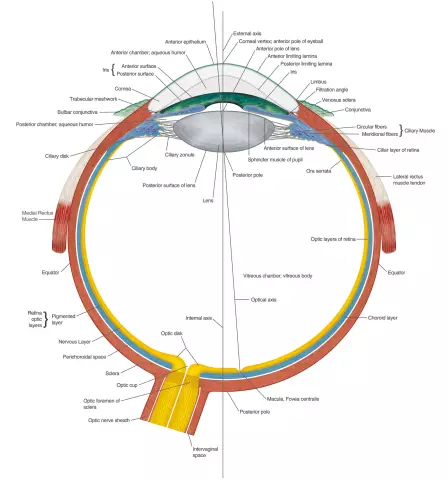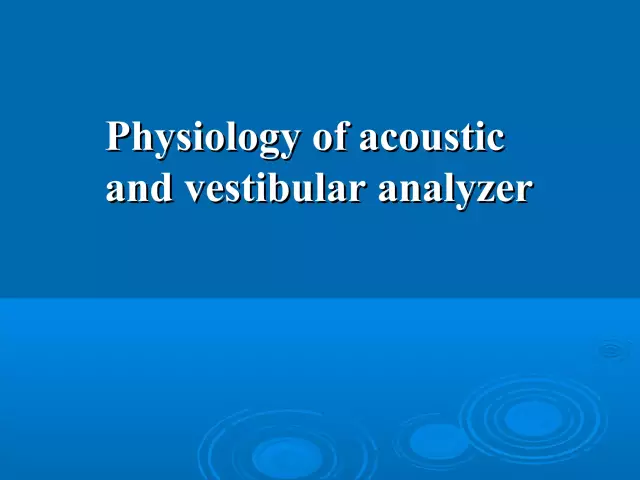- Author Curtis Blomfield [email protected].
- Public 2023-12-16 20:44.
- Last modified 2025-01-23 17:01.
To interact with the outside world, a person needs to receive and analyze information from the external environment. For this, nature endowed him with sense organs. There are six of them: eyes, ears, tongue, nose, skin and vestibular apparatus. Thus, a person forms an idea about everything that surrounds him and about himself as a result of visual, auditory, olfactory, tactile, gustatory and kinesthetic sensations.
It can hardly be argued that any sense organ is more significant than the others. They complement each other, creating a complete picture of the world. But the fact that most of all information - up to 90%! - people perceive with the help of the eyes - this is a fact. To understand how this information enters the brain and how it is analyzed, you need to understand the structure and functions of the visual analyzer.

Features of the visual analyzer
Thanks to visual perception, we learn about the size, shape, color, relative position of objects in the world, their movement orimmobility. This is a complex and multi-stage process. The structure and functions of the visual analyzer - a system that receives and processes visual information, and thereby provides vision - are very complex. Initially, it can be divided into peripheral (perceiving the initial data), conducting and analyzing parts. Information is received through the receptor apparatus, which includes the eyeball and auxiliary systems, and then it is sent with the help of the optic nerves to the corresponding centers of the brain, where it is processed and visual images are formed. All departments of the visual analyzer will be discussed in the article.

How the eye works. Outer layer of the eyeball
The eyes are a paired organ. Each eyeball is shaped like a slightly flattened ball and consists of several shells: external, middle and internal, surrounding the fluid-filled cavities of the eye.
The outer shell is a dense fibrous capsule that preserves the shape of the eye and protects its internal structures. In addition, six motor muscles of the eyeball are attached to it. The outer shell consists of a transparent front part - the cornea, and a back, opaque part - the sclera.
The cornea is the refractive medium of the eye, it is convex, looks like a lens and consists, in turn, of several layers. There are no blood vessels in it, but there are many nerve endings. White or bluish sclera, the visible part of which is usually called proteineye, formed from connective tissue. Muscles are attached to it, providing turns of the eyes.
Middle layer of the eyeball
The middle choroid is involved in metabolic processes, providing nutrition to the eye and the removal of metabolic products. The front, most noticeable part of it is the iris. The pigment substance in the iris, or rather, its quantity, determines the individual shade of a person's eyes: from blue, if there is not enough of it, to brown, if enough. If the pigment is absent, as happens with albinism, then the vascular plexus becomes visible, and the iris becomes red.

The iris is located just behind the cornea and is based on muscles. The pupil - a rounded hole in the center of the iris - thanks to these muscles regulates the penetration of light into the eye, expanding in low light and narrowing in too bright. The continuation of the iris is the ciliary (ciliary) body. The function of this part of the visual analyzer is to produce a fluid that nourishes those parts of the eye that do not have their own vessels. In addition, the ciliary body has a direct influence on the thickness of the lens through special ligaments.
In the back of the eye in the middle layer is the choroid, or the choroid itself, almost entirely consisting of blood vessels of different diameters.

Retina
The inner, thinnest layer is the retina, or retina, formednerve cells. Here there is a direct perception and primary analysis of visual information. The back of the retina is made up of specialized photoreceptors called cones (7 million) and rods (130 million). They are responsible for the perception of objects by the eye.
Cones are responsible for color recognition and provide central vision, allow you to see the smallest details. Rods, being more sensitive, enable a person to see in black and white colors in poor lighting conditions, and are also responsible for peripheral vision. Most of the cones are concentrated in the so-called macula opposite the pupil, slightly above the entrance of the optic nerve. This place corresponds to the maximum visual acuity. The retina, as well as all parts of the visual analyzer, has a complex structure - 10 layers are distinguished in its structure.
The structure of the eye cavity
The ocular nucleus consists of the lens, the vitreous body and chambers filled with fluid. The lens looks like a convex transparent lens on both sides. It has neither vessels nor nerve endings and is suspended from the processes of the ciliary body surrounding it, the muscles of which change its curvature. This ability is called accommodation and helps the eye to focus on close or, conversely, distant objects.
Behind the lens, adjacent to it and further to the entire surface of the retina, is the vitreous body. This is a transparent gelatinous substance that fills most of the volume of the organ of vision. This gel-like mass contains 98% water. The purpose of this substance isconduction of light rays, compensation for intraocular pressure drops, maintaining the constancy of the shape of the eyeball.
The anterior chamber of the eye is limited by the cornea and iris. It connects through the pupil to a narrower posterior chamber extending from the iris to the lens. Both cavities are filled with intraocular fluid, which freely circulates between them.
Refraction of light
The system of the visual analyzer is such that initially the light rays are refracted and focused on the cornea and pass through the anterior chamber to the iris. Through the pupil, the central part of the light flux enters the lens, where it is more accurately focused, and then through the vitreous to the retina. An image of an object is projected on the retina in a reduced and, moreover, inverted form, and the energy of light rays is converted by photoreceptors into nerve impulses. The information then travels to the brain via the optic nerve. The place on the retina through which the optic nerve passes is devoid of photoreceptors, therefore it is called the blind spot.

Motor apparatus of the organ of vision
The eye, in order to respond in a timely manner to stimuli, must be mobile. Three pairs of oculomotor muscles are responsible for the movement of the visual apparatus: two pairs of straight and one oblique. These muscles are perhaps the fastest-acting in the human body. The oculomotor nerve controls the movement of the eyeball. It connects four of the six eye muscles with the nervous system, ensuring their adequate work andcoordinated eye movements. If the oculomotor nerve ceases to function normally for some reason, this is expressed in various symptoms: strabismus, eyelid drooping, double vision, pupil dilation, accommodation disturbances, protrusion of the eyes.

Protective eye systems
Continuing such a voluminous topic as the structure and functions of the visual analyzer, one cannot fail to mention those systems that protect it. The eyeball is located in the bone cavity - the orbit, on a shock-absorbing fat pad, where it is reliably protected from impact.
In addition to the eye socket, the protective apparatus of the organ of vision includes the upper and lower eyelids with eyelashes. They protect the eyes from the ingress of various objects from the outside. In addition, the eyelids help to evenly distribute tear fluid over the surface of the eye, remove the smallest dust particles from the cornea when blinking. Eyebrows also perform a protective function to some extent, protecting the eyes from sweat flowing from the forehead.
Lacrimal glands are located in the upper outer corner of the orbit. Their secret protects, nourishes and moisturizes the cornea, and also has a disinfecting effect. Excess fluid drains through the tear duct into the nasal cavity.
Further processing and final processing of information
The conductor section of the analyzer consists of a pair of optic nerves that exit the eye sockets and enter special canals in the cranial cavity, further forming an incomplete decussation, or chiasma. Images from the temporal (outer) partthe retinas remain on the same side, but from the inner, nasal, they cross and are transmitted to the opposite side of the brain. As a result, it turns out that the right visual fields are processed by the left hemisphere, and the left ones by the right. Such an intersection is necessary to form a three-dimensional visual image.
After decussation, the nerves of the conduction section continue in the optic tracts. Visual information enters the part of the cerebral cortex that is responsible for its processing. This zone is located in the occipital region. There, the final transformation of the received information into a visual sensation takes place. This is the central part of the visual analyzer.
So, the structure and functions of the visual analyzer are such that violations in any of its sections, whether it be the perceiving, conducting or analyzing zones, entail a failure of its work as a whole. This is a very multifaceted, subtle and perfect system.

Disorders of the visual analyzer - congenital or acquired - in turn lead to significant difficulties in cognition of reality and limited opportunities.






